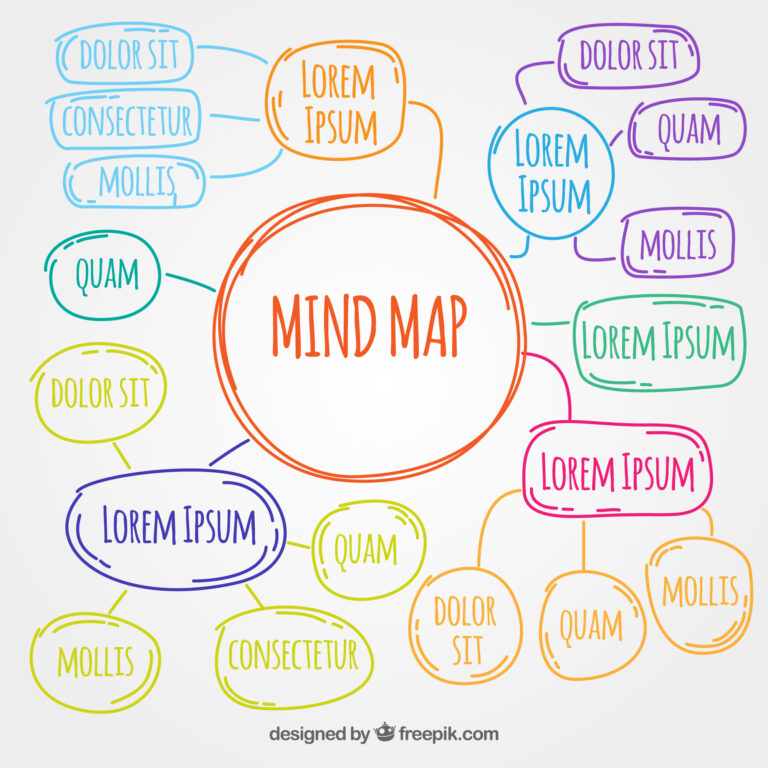
Start a search for “brainstorming” or “brainstorming definition” and you’re bound to get many results pertaining to groups. In fact, of the two official definitions of brainstorming, the first only identifies it as a group activity. It isn’t until the second definition that the dictionary admits this is a task that can be accomplished by a solitary person. But for the purposes of this post, I’m going to assume that the “you” I’m talking to is an individual. And that “you” are brainstorming for one of two reasons: choosing a topic to write about or choosing what to include when writing about that topic. Though much of what I’ll cover would also apply to any marketing activities you’re working on (social media content, email marketing, etc), my intent is to show you how to brainstorm for blogging.
You’ll generally see the term “prewriting” in more academic circles, such as in a college English class or on the student resource section of a university website. But the activities they lump into prewriting – ideation, brainstorming, and outlining – apply to any type of writing, including blogging.
Brainstorming and ideation are often used interchangeably (and truthfully, they can be used interchangeably in almost every circumstance). But for the purposes of this blog, I’m going to consider them separate and different actions. Here’s how I’ll use each.
As an example, it’s the first of the month and you jot down a whole list of topics on a notepad to determine what you want to blog about. That’s ideation. You pick two topics and then begin scribbling down all the things you think need to be included in each of those blogs. That’s brainstorming.
In the coming weeks, you’ll see a separate blog on ideation as well as outlining. Make sure to subscribe to our newsletter so you’ll know when we launch our comprehensive guide to blogging due at the end of January 2024!
So you’ve decided what you want to write about, but now you need to decide what information to include in your blog. It’s time to brainstorm. Here are some effective techniques, including my personal favorite at the bottom.
Mind mapping is one of the most popular ways to brainstorm for writing and is always one of the first results on Google. Here’s a simplified step-by-step on how to use mind mapping to write your blog outline.

Freewriting is a great way to “just get started,” and one of the simplest ways to brainstorm, or even write the whole blog. Start by opening a document on your computer and begin typing all your thoughts on your intended topic. Don’t worry about the order or logic. The time to edit will come later. For now, just get all your ideas out in longer phrases or full sentences.
Once you’ve written everything down you can think of, begin rearranging the content into a logical flow. Add notes of where you need to work in transitions or more content. Then complete the blog by following your own notes. See? Super simple.
Personally, I use this tactic a lot when I’m writing my own content or on a topic I know a lot about. Freewriting can backfire, however, if you’re someone who struggles to organize their thoughts once they’ve written them out. If that’s the case for you, I’d choose one of the more structured approaches listed here.
Question-answer is not only a great brainstorming technique, it can be a great way to write your whole blog post. Here’s an example of a blog I wrote for a client in that format. But even if you don’t like that finished format, don’t dismiss the technique. Here’s how you can use and still write your blog more conversationally:
If there’s an actual name for this technique, I have yet to find it. So I’ve named it myself. This was taught to me by my 7th Grade English teacher as a way to get down all your ideas to outline a paper. I suspect that this is actually a variation on mind mapping modified for the middle school brain. But it remains my favorite technique (and I’m well past middle school!).
One of the things I love about it is that, unlike traditional mind mapping, you don’t have to organize your thoughts as you go. Rather, you just dump out all your ideas and tidbits of information you want to be sure to include onto the page in whatever spot your heart desires.
Here’s how to do it (and a short video):
During the brainstorming phase, I encourage you to not worry about having too many ideas. Rather, let all your thoughts and ideas flow out onto the page – digital or physical. The time to pair down will be when you outline. I cover that more here (stay tuned!)
A couple of things could be causing this: you don’t feel passionate about the topic; you’re trying too hard; or you need a break. What made you decide to write on this topic? Is it something you get asked a lot and you’re tired of being asked about? Maybe let the anger/annoyance fuel your brainstorming and even writing. Freewrite all the things you *wish* you could say to people when they ask this question. Then go back and edit for niceness/professionalism.
Does the topic bore you but it’s something you need to write about due to popularity? Try writing all the reasons you think it’s a boring question and see what comes up.
Have you simply been staring at your computer screen or blank page for too long? Maybe you just need a break. Or a walk.
Consider asking an AI writing tool what it would write about the topic. I find AI can be a useful tool sometimes. And other times I don’t care much for what it comes up with. But it can help you move from stuck to getting words on the page.
Lastly, if you just can’t come up with enough content to create a blog, relegate the topic to a social media post or skip it entirely. There’s bound to be something you’re excited to write about!
Brainstorming is one of the most effective ways to ensure your blog is organized and has sufficient content. It’s also a great way to not forget about anything you were hoping to say on your topic!
I’d love it if you could share this blog with someone currently struggling to organize their thoughts – or just looking for more guidance on blog writing!
I’m in the midst of creating a guide to blog writing with small business owners and solopreneurs in mind. Be sure to get on my email list to know when it drops in early 2024.
Effective organic marketing can help you hit all your goals.
Organically grow your business through strategic marketing tips.